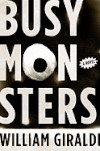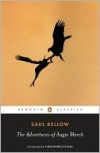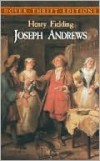
July 20, 2012 - Publishers Weekly
Busy Monsters (newly released in paperback) is about a jilted fiance who embarks on a hilarious, ill-advised odyssey to win back his beloved. It's also a picaresque. What's a picaresque? Author William Giraldi explains, while also giving you his five favorites.
 “Picaresque” is an eely tag. The Spanish word picaresca came from picaro, first used in the early 1600s and which in English can mean rogue, bohemian, adventurer, rapscallion. We took picaron, the augmentative of picaro, and made the accusatory-sounding “picaroon,” a lovely synonym for “picaro” that Merriam-Webster will tell you also means “pirate,” although Picaroons of the Caribbean doesn’t have the ring it should. The picaresque novel—the term wasn’t coined in English until the early nineteenth century—has shape-shifted since its first known incarnation in Spain, the anonymously authored Lazarillo de Tormes, published in 1553. But most picaresque novels incorporate several defining characteristics: satire, comedy, sarcasm, acerbic social criticism; first-person narration with an autobiographical ease of telling; an outsider protagonist-seeker on an episodic and often pointless quest for renewal or justice.
“Picaresque” is an eely tag. The Spanish word picaresca came from picaro, first used in the early 1600s and which in English can mean rogue, bohemian, adventurer, rapscallion. We took picaron, the augmentative of picaro, and made the accusatory-sounding “picaroon,” a lovely synonym for “picaro” that Merriam-Webster will tell you also means “pirate,” although Picaroons of the Caribbean doesn’t have the ring it should. The picaresque novel—the term wasn’t coined in English until the early nineteenth century—has shape-shifted since its first known incarnation in Spain, the anonymously authored Lazarillo de Tormes, published in 1553. But most picaresque novels incorporate several defining characteristics: satire, comedy, sarcasm, acerbic social criticism; first-person narration with an autobiographical ease of telling; an outsider protagonist-seeker on an episodic and often pointless quest for renewal or justice.
Those traits set a broad trap certain to snag many a novel that never thought of itself as a picaresque; minus the satire, they very well could describe Kerouac’s On the Road. The road novel, like the quest epic, is a genre unto itself, but it just so happens that the terms of the picaresque require travel, which might have something to do with the title of what is sometimes cited as the first picaresque in English, The Unfortunate Traveller by Thomas Nashe, published in 1594, a miserable and barely readable book. Tweak the traditional traits of the picaresque just a pinch and think of all the titles that might apply. My own novel, Busy Monsters, has two direct ancestors I can name, both of which contain elements of the picaresque among the manifold traits that constitute their genius: The Odyssey and Don Quixote. I filched from them openly, as I filched from these five immortal picaresque novels:
 1. The Adventures of Augie March by Saul Bellow - A contender for the novel of our national consciousness, Augie March begins with the resounding and ecstatic line, “I am an American, Chicago born,” and doesn’t let up for five-hundred pages. In his letters Bellow disparages the term “picaresque” and those who utter it in earnest, but in Augie March you can feel him channeling Henry Fielding and the picaresque tradition. When Martin Amis dubs Bellow the greatest American novelist—greater than Melville, Twain, or James—he refers to the middle-period Bellow of Henderson the Rain King, Herzog and Humboldt’s Gift, but it’s Augie March that captures the American character in all its untamed exuberance.
1. The Adventures of Augie March by Saul Bellow - A contender for the novel of our national consciousness, Augie March begins with the resounding and ecstatic line, “I am an American, Chicago born,” and doesn’t let up for five-hundred pages. In his letters Bellow disparages the term “picaresque” and those who utter it in earnest, but in Augie March you can feel him channeling Henry Fielding and the picaresque tradition. When Martin Amis dubs Bellow the greatest American novelist—greater than Melville, Twain, or James—he refers to the middle-period Bellow of Henderson the Rain King, Herzog and Humboldt’s Gift, but it’s Augie March that captures the American character in all its untamed exuberance. 2. Joseph Andrews by Henry Fielding - On the title page of Joseph Andrews you can find Fielding’s debt: “Written in Imitation of the Manner of Cervantes, Author of Don Quixote.” His first published novel after a decade as a playwright, Joseph Andrews falls just shy of the unmitigated greatness of Tom Jones, and yet it is the Fielding novel I found myself thinking of almost daily during the composition of Busy Monsters. Fielding called Joseph Andrews a “comic Epic-Poem in Prose,” and although he was being intentionally grandiose, the label fits. Part of what makes the novel so delicious is its scathing parody of Samuel Richardson’s outrageously popular novel Pamela, whose pharisaical moralizing disgusted Fielding. Its straight-faced subtitle is “Virtue Rewarded,” and Fielding knew this was a prudish ruse.
2. Joseph Andrews by Henry Fielding - On the title page of Joseph Andrews you can find Fielding’s debt: “Written in Imitation of the Manner of Cervantes, Author of Don Quixote.” His first published novel after a decade as a playwright, Joseph Andrews falls just shy of the unmitigated greatness of Tom Jones, and yet it is the Fielding novel I found myself thinking of almost daily during the composition of Busy Monsters. Fielding called Joseph Andrews a “comic Epic-Poem in Prose,” and although he was being intentionally grandiose, the label fits. Part of what makes the novel so delicious is its scathing parody of Samuel Richardson’s outrageously popular novel Pamela, whose pharisaical moralizing disgusted Fielding. Its straight-faced subtitle is “Virtue Rewarded,” and Fielding knew this was a prudish ruse.
1 comment:
Fine, but I don't think I'll use 'picaresque' as one of the seven genre descriptions I'm allocated on Amazon to persuade browsers to read my book - tho' picaresque it indeed is. Won't plug. Try looking under 'picaresque;' I might change my mind.
Post a Comment